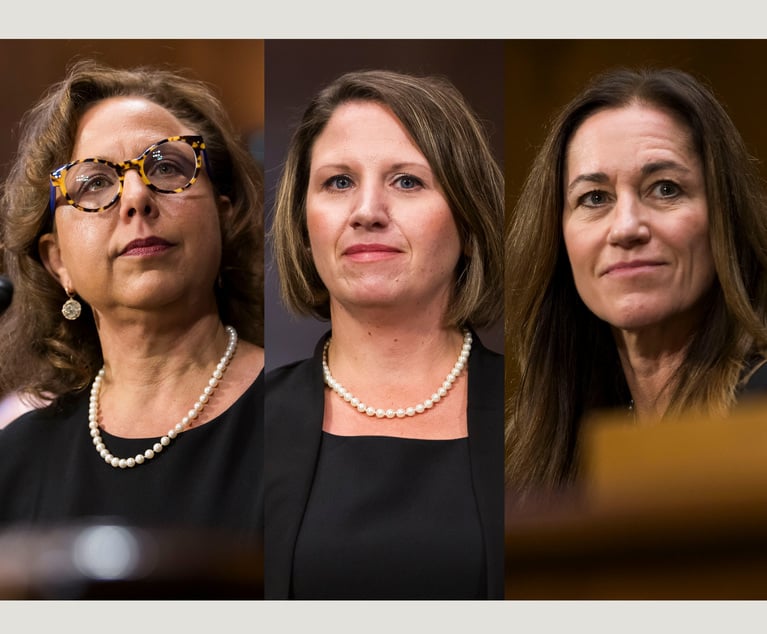Commonwealth Court Considers Municipal Boundary Disputes
This past May, a curio story made international news when a Belgian farmer moved a stone monument on his property by approximately 7.2 feet.
June 17, 2021 at 09:54 AM
8 minute read
 Anna S. Jewart and Blaine Lucas, Babst, Calland, Clements and Zomnir (Photo: Courtesy Photo)
Anna S. Jewart and Blaine Lucas, Babst, Calland, Clements and Zomnir (Photo: Courtesy Photo) This past May, a curio story made international news when a Belgian farmer moved a stone monument on his property by approximately 7.2 feet. While this typically would have remained unknown, except to the farmer and perhaps to his neighbor, the farmer did not consider that the stone had been placed in 1819 to mark his home country's border with France, and moving it resulted in an approximate 3,000-square-foot loss of territory for the French. Luckily, the change in location was quickly caught and resolved without international incident. The quick discovery and resulting amicable resolution between the two nations was made possible in large part because the local Belgian municipality, Erquelinnes, had geo-localized the stones in 2019 for its 200th anniversary and knew exactly where it should have been. A few days after the story went viral, the Pennsylvania Commonwealth Court addressed what happens when municipalities here misplace their historic markers and later disagree over the location of their common boundaries. In Woodward Township Municipal Corporation of Clinton County, Pennsylvania v. Dunnstable Township Municipal Corporation of Clinton County, Pennsylvania, Nos. 704 C.D. 2020, 733 C.D. 2020 (Pa. Cmwlth. May 12, 2021), disagreement over boundary stones and surveys dating back to 1844 resulted in a modern-day battle of the experts to determine exactly where the shared boundary of the two townships actually lies.
Although it was avoided by the farmer in Erquelinnes, wars and lawsuits are often fought over the location of boundaries, whether they are private, municipal or international. Consequently, Pennsylvania law provides certain protections for the agreed-upon location of municipal boundaries, and establishes procedures for both how to change them willingly, and how to resolve disputes surrounding their location. Article III, Section 32 of the Pennsylvania Constitution prohibits the state legislature from passing any local or special law that creates new counties, townships or boroughs or changes county limits, township lines, borough limits or school districts. In turn, it grants the electors of a municipality the right to consolidate, merge, and change boundaries by initiative and referendum, without the approval of any governing body.
This content has been archived. It is available through our partners, LexisNexis® and Bloomberg Law.
To view this content, please continue to their sites.
Not a Lexis Subscriber?
Subscribe Now
Not a Bloomberg Law Subscriber?
Subscribe Now
NOT FOR REPRINT
© 2025 ALM Global, LLC, All Rights Reserved. Request academic re-use from www.copyright.com. All other uses, submit a request to [email protected]. For more information visit Asset & Logo Licensing.
You Might Like
View All
Pa. Federal District Courts Reach Full Complement Following Latest Confirmation

The Defense Bar Is Feeling the Strain: Busy Med Mal Trial Schedules Might Be Phila.'s 'New Normal'
7 minute read
Federal Judge Allows Elderly Woman's Consumer Protection Suit to Proceed Against Citizens Bank
5 minute read
Judge Leaves Statute of Limitations Question in Injury Crash Suit for a Jury
4 minute readLaw Firms Mentioned
Trending Stories
- 1Uber Files RICO Suit Against Plaintiff-Side Firms Alleging Fraudulent Injury Claims
- 2The Law Firm Disrupted: Scrutinizing the Elephant More Than the Mouse
- 3Inherent Diminished Value Damages Unavailable to 3rd-Party Claimants, Court Says
- 4Pa. Defense Firm Sued by Client Over Ex-Eagles Player's $43.5M Med Mal Win
- 5Losses Mount at Morris Manning, but Departing Ex-Chair Stays Bullish About His Old Firm's Future
Who Got The Work
J. Brugh Lower of Gibbons has entered an appearance for industrial equipment supplier Devco Corporation in a pending trademark infringement lawsuit. The suit, accusing the defendant of selling knock-off Graco products, was filed Dec. 18 in New Jersey District Court by Rivkin Radler on behalf of Graco Inc. and Graco Minnesota. The case, assigned to U.S. District Judge Zahid N. Quraishi, is 3:24-cv-11294, Graco Inc. et al v. Devco Corporation.
Who Got The Work
Rebecca Maller-Stein and Kent A. Yalowitz of Arnold & Porter Kaye Scholer have entered their appearances for Hanaco Venture Capital and its executives, Lior Prosor and David Frankel, in a pending securities lawsuit. The action, filed on Dec. 24 in New York Southern District Court by Zell, Aron & Co. on behalf of Goldeneye Advisors, accuses the defendants of negligently and fraudulently managing the plaintiff's $1 million investment. The case, assigned to U.S. District Judge Vernon S. Broderick, is 1:24-cv-09918, Goldeneye Advisors, LLC v. Hanaco Venture Capital, Ltd. et al.
Who Got The Work
Attorneys from A&O Shearman has stepped in as defense counsel for Toronto-Dominion Bank and other defendants in a pending securities class action. The suit, filed Dec. 11 in New York Southern District Court by Bleichmar Fonti & Auld, accuses the defendants of concealing the bank's 'pervasive' deficiencies in regards to its compliance with the Bank Secrecy Act and the quality of its anti-money laundering controls. The case, assigned to U.S. District Judge Arun Subramanian, is 1:24-cv-09445, Gonzalez v. The Toronto-Dominion Bank et al.
Who Got The Work
Crown Castle International, a Pennsylvania company providing shared communications infrastructure, has turned to Luke D. Wolf of Gordon Rees Scully Mansukhani to fend off a pending breach-of-contract lawsuit. The court action, filed Nov. 25 in Michigan Eastern District Court by Hooper Hathaway PC on behalf of The Town Residences LLC, accuses Crown Castle of failing to transfer approximately $30,000 in utility payments from T-Mobile in breach of a roof-top lease and assignment agreement. The case, assigned to U.S. District Judge Susan K. Declercq, is 2:24-cv-13131, The Town Residences LLC v. T-Mobile US, Inc. et al.
Who Got The Work
Wilfred P. Coronato and Daniel M. Schwartz of McCarter & English have stepped in as defense counsel to Electrolux Home Products Inc. in a pending product liability lawsuit. The court action, filed Nov. 26 in New York Eastern District Court by Poulos Lopiccolo PC and Nagel Rice LLP on behalf of David Stern, alleges that the defendant's refrigerators’ drawers and shelving repeatedly break and fall apart within months after purchase. The case, assigned to U.S. District Judge Joan M. Azrack, is 2:24-cv-08204, Stern v. Electrolux Home Products, Inc.
Featured Firms
Law Offices of Gary Martin Hays & Associates, P.C.
(470) 294-1674
Law Offices of Mark E. Salomone
(857) 444-6468
Smith & Hassler
(713) 739-1250





